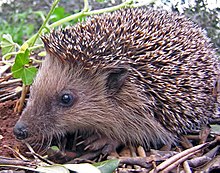
Back قنفذ Arabic قنفذ ARZ Erinaceinae AST Сапраўдныя вожыкі Byelorussian Таралежи Bulgarian কাঁটাচুয়া Bengali/Bangla རྒང་། Tibetan Jež BS Eriçons Catalan ژووشک CKB
| Hedgehogs[1] Temporal range:
| |
|---|---|

| |
| European hedgehog | |
| Scientific classification | |
| Domain: | Eukaryota |
| Kingdom: | Animalia |
| Phylum: | Chordata |
| Class: | Mammalia |
| Order: | Eulipotyphla |
| Family: | Erinaceidae |
| Subfamily: | Erinaceinae G. Fischer, 1814 |
| Type genus | |
| Erinaceus | |
| Genera | |
A hedgehog is a spiny mammal of the subfamily Erinaceinae, in the eulipotyphlan family Erinaceidae. There are seventeen species of hedgehog in five genera found throughout parts of Europe, Asia, and Africa, and in New Zealand by introduction. There are no hedgehogs native to Australia and no living species native to the Americas. However, the extinct genus Amphechinus was once present in North America.
Hedgehogs share distant ancestry with shrews (family Soricidae), with gymnures possibly being the intermediate link, and they have changed little over the last fifteen million years.[2] Like many of the first mammals, they have adapted to a nocturnal way of life.[3] Their spiny protection resembles that of porcupines, which are rodents, and echidnas, a type of monotreme.
- ^ Hutterer, R. (2005). "Order Erinaceomorpha". In Wilson, D.E.; Reeder, D.M (eds.). Mammal Species of the World: A Taxonomic and Geographic Reference (3rd ed.). Johns Hopkins University Press. pp. 212–217. ISBN 978-0-8018-8221-0. OCLC 62265494.
- ^ Reiter C, Gould GC (1998). "Thirteen Ways of Looking at a Hedgehog". Natural History. 107 (6): 52.
- ^ "WildlifeTrust.org.uk". WildlifeTrust.org.uk. Archived from the original on 12 February 2013. Retrieved 28 February 2013.
© MMXXIII Rich X Search. We shall prevail. All rights reserved. Rich X Search